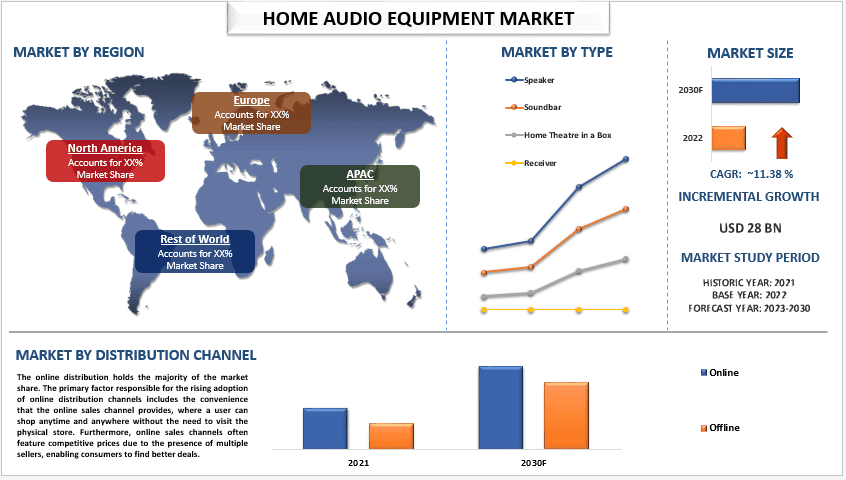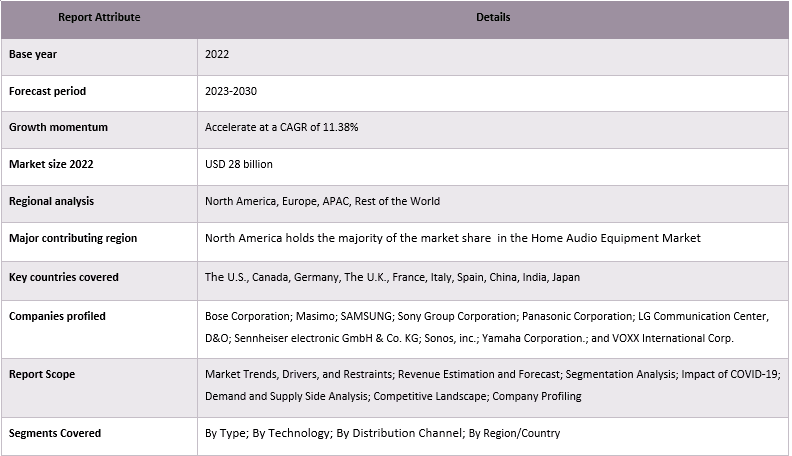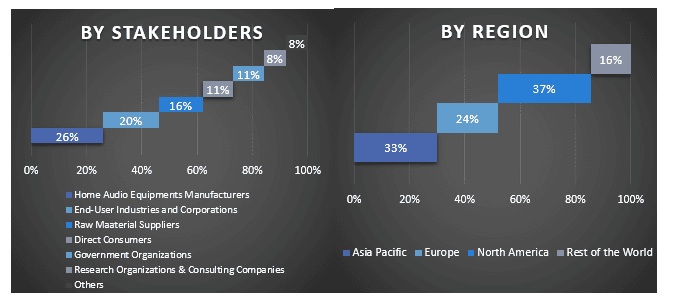- Home
- About Us
- Industry
- Services
- Reading
- Contact Us
Home Audio Equipment Market: Current Analysis and Forecast (2023-2030)
Emphasis on Type (Speaker, Soundbar, Home Theatre In A Box (HTIB), and Receiver), Technology (Wired and Wireless.); Distribution Channel (Online and Offline); and Region/Country

The Home Audio Equipment Market was valued at 28 billion in the year 2022 and is expected to grow at a strong rate of around 11.38% during the forecast period (2023-2030), owing to the rising streaming services and surging demand for the smart home products in the market. Furthermore, Innovation in wireless connectivity, smart technologies, voice assistants, and Internet of Things (IoT) integration are driving the adoption of home audio equipment. Moreover, with the astronomical rise of streaming platforms, such as music and video-on-demand services, there is a higher demand for quality audio systems to enjoy multimedia content at home. Additionally, increasing disposable income globally is enabling consumers to invest in premium home audio equipment. These are some of the factors leading to the increased demand of the home audio equipment market and this rise in demand can also be assessed from the increasing product launches and investments that are undergoing in this space. For instance, in August 2023, Bang & Olufsen announced a partnership with an automotive company Ferrari for launching collection of audio products bearing both the brands logos.
Some of the major players operating in the market include Bose Corporation; Masimo; SAMSUNG; Sony Group Corporation; Panasonic Corporation; LG Communication Center, D&O; Sennheiser electronic GmbH & Co. KG; Sonos, inc.; Yamaha Corporation.; and VOXX International Corp. Several M&As along with partnerships have been undertaken by these players to facilitate customers with hi-tech and innovative products/technologies.
Insights Presented in the Report
“Amongst type, the soundbar segment held the significant share of the market in 2022.”
Based on type, the market is segmented into speaker, soundbar, home theatre in a box (HTIB), and receiver. The soundbar segment is anticipated to witness significant growth in the forecasted period. The primary factors that are responsible for this elevated growth rate of the soundbar segment include the rising demand for enhanced audio experience due to soundbars’ ability to provide an improved audio experience compared to traditional speakers. Furthermore, the growing popularity of soundbars is also due to the increasing demand for high-quality audio solutions and smart audio/video devices. Soundbars are a cost-effective alternative to stereo sound systems that drastically improve the audio quality in the user’s living room, meeting/conference room, or home theater. The primary reason behind the increasing adoption of soundbars is their ability to stream audio content wirelessly and enhance the overall sound experience. Moreover, rapid technological advancement, growing internet penetration, digital transformation of the broadcasting industry, increasing number of smart homes, and declining product prices also contribute to the growing demand for soundbars. This elevated demand has further encouraged the companies operating in this segment to develop and launch various new products.
“Amongst distribution channel, the online sales channel is anticipated to grow at a significant CAGR during the forecast period (2023-2030).”
Based on distribution channel, the market is bifurcated into online and offline sales channels. Online distribution holds the majority of the market share. The primary factor responsible for the rising adoption of online distribution channels includes the convenience that the online sales channel provides, where a user can shop anytime and anywhere without the need to visit the physical store. Furthermore, online sales channels often feature competitive prices due to the presence of multiple sellers, enabling consumers to find better deals. Additionally, consumers can easily compare prices, features, and customer reviews of different home audio equipment brands, helping them make informed purchasing decisions, which is also one of the primary factors contributing to the increased traffic of consumers on online sales channels. In addition to this, online sales channel features user review and rating, home delivery, and also have a wide reach to consumers, hence playing a dominating role in the distribution of home audio equipment in the market.
“North America to lead the growth in the home audio equipment segment during the forecasted period (2022-2030).”
North America stands out as a significant market for home audio equipment. Several factors contribute to its high market share which includes strong consumer demand, where North America has a substantial consumer base with a high standard of living, leading to a strong demand for home audio equipment. Furthermore, North America has been at the forefront of technological advancements, continually introducing innovative home audio technologies. This includes advancements in wireless connectivity, voice control integration, and smart home compatibility. Such technological advancements attract consumers and contribute to the growth of the market. Moreover, North America has a robust and well-developed distribution network that efficiently connects manufacturers, suppliers, retailers, and consumers which also plays a significant role in driving the demand with high visibility and accessibility of the product to the consumers. In addition to this, the region’s relatively high disposable income level enhances the purchasing power of individuals to invest in sophisticated home audio systems where integration with voice assistants, home automation systems, and smart home devices has become increasingly popular among consumers, driving the market for connected audio solutions.
Home Audio Equipment Market Report Coverage

Reasons to buy this report:
- The study includes market sizing and forecasting analysis validated by authenticated key industry experts.
- The report presents a quick review of overall industry performance at one glance.
- The report covers an in-depth analysis of prominent industry peers with a primary focus on key business financials, product portfolios, expansion strategies, and recent developments.
- Detailed examination of drivers, restraints, key trends, and opportunities prevailing in the industry.
- The study comprehensively covers the market across different segments.
- Deep dive regional level analysis of the industry.
Customization Options:
The global home audio equipment market can further be customized as per the requirement or any other market segment. Besides this, UMI understands that you may have your own business needs, hence feel free to contact us to get a report that completely suits your requirements.
Table of Content
Research Methodology for the Home Audio Equipment Market Analysis (2023-2030)
Analyzing the historical market, estimating the current market, and forecasting the future market of the global home audio equipment market were the three major steps undertaken to create and analyze the adoption of home audio equipment in major regions globally. Exhaustive secondary research was conducted to collect the historical market numbers and estimate the current market size. Secondly, to validate these insights, numerous findings and assumptions were taken into consideration. Moreover, exhaustive primary interviews were also conducted, with industry experts across the value chain of the global home audio equipment market. Post assumption and validation of market numbers through primary interviews, we employed a top-down/bottom-up approach to forecasting the complete market size. Thereafter, market breakdown and data triangulation methods were adopted to estimate and analyze the market size of segments and sub-segments of the industry pertains to. Detailed methodology is explained below:
Analysis of Historical Market Size
Step 1: In-Depth Study of Secondary Sources:
A detailed secondary study was conducted to obtain the historical market size of the home audio equipment market through company internal sources such as annual reports & financial statements, performance presentations, press releases, etc., and external sources including journals, news & articles, government publications, competitor publications, sector reports, third-party database, and other credible publications.
Step 2: Market Segmentation:
After obtaining the historical market size of the home audio equipment market, we conducted a detailed secondary analysis to gather historical market insights and share for different segments & sub-segments for major regions. Major segments are included in the report as type, technology, and distribution channel . Further country-level analyses were conducted to evaluate the overall adoption of testing models in that region.
Step 3: Factor Analysis:
After acquiring the historical market size of different segments and sub-segments, we conducted a detailed factor analysis to estimate the current market size of the Home Audio Equipment market. Further, we conducted factor analysis using dependent and independent variables such as type and end-user industry of the home audio equipment market. A thorough analysis was conducted for demand and supply-side scenarios considering top partnerships, mergers and acquisitions, business expansion, and product launches in the home audio equipment market sector across the globe.
Current Market Size Estimate & Forecast
Current Market Sizing: Based on actionable insights from the above 3 steps, we arrived at the current market size, key players in the global Home Audio Equipment market, and market shares of the segments. All the required percentage shares split, and market breakdowns were determined using the above-mentioned secondary approach and were verified through primary interviews.
Estimation & Forecasting: For market estimation and forecast, weights were assigned to different factors including drivers & trends, restraints, and opportunities available for the stakeholders. After analyzing these factors, relevant forecasting techniques i.e., the top-down/bottom-up approach were applied to arrive at the market forecast for 2030 for different segments and sub-segments across the major markets globally. The research methodology adopted to estimate the market size encompasses:
- The industry’s market size, in terms of revenue (USD) and the adoption rate of the home audio equipment market across the major markets domestically
- All percentage shares, splits, and breakdowns of market segments and sub-segments
- Key players in the global home audio equipment market in terms of products offered. Also, the growth strategies adopted by these players to compete in the fast-growing market.
Market Size and Share Validation
Primary Research: In-depth interviews were conducted with the Key Opinion Leaders (KOLs) including Top Level Executives (CXO/VPs, Sales Head, Marketing Head, Operational Head, Regional Head, Country Head, etc.) across major regions. Primary research findings were then summarized, and statistical analysis was performed to prove the stated hypothesis. Inputs from primary research were consolidated with secondary findings, hence turning information into actionable insights.
Split of Primary Participants in Different Regions

Market Engineering
The data triangulation technique was employed to complete the overall market estimation and to arrive at precise statistical numbers for each segment and sub-segment of the global home audio equipment market. data was split into several segments & sub-segments post studying various parameters and trends in the areas of the type and end-user industry in the global home audio equipment market.
The main objective of the Global Home Audio Equipment Market Study
The current & future market trends of the global home audio equipment market were pinpointed in the study. Investors can gain strategic insights to base their discretion for investments on the qualitative and quantitative analysis performed in the study. Current and future market trends determined the overall attractiveness of the market at a regional level, providing a platform for the industrial participant to exploit the untapped market to benefit from a first-mover advantage. Other quantitative goals of the studies include:
- Analyze the current and forecast market size of the home audio equipment market in terms of value (USD). Also, analyze the current and forecast market size of different segments and sub-segments.
- Segments in the study include areas of type, technology, and distribution channel.
- Define and analyze the regulatory framework for the home audio equipment
- Analyze the value chain involved with the presence of various intermediaries, along with analyzing customer and competitor behaviors of the industry.
- Analyze the current and forecast market size of the home audio equipment market for the major region
- Major countries of regions studied in the report include Asia Pacific, Europe, North America, and the Rest of the World
- Company profiles of the home audio equipment market and the growth strategies adopted by the market players to sustain in the fast-growing market
- Deep dive regional level analysis of the industry
Frequently Asked Questions FAQs
Q1: What is the current market size and growth potential of the global Home Audio Equipment market?
Q2: What are the driving factors for the growth of the global Home Audio Equipment Market?
Q3: Which segment has the largest share of the global Home Audio Equipment market by Type?
Q4: What are the emerging technologies and trends in the global Home Audio Equipment market?
Q5: Which region will dominate the global Home Audio Equipment market?
Q6: Who are the key players operating in the global Home Audio Equipment market?
Related Reports
Customers who bought this item also bought










